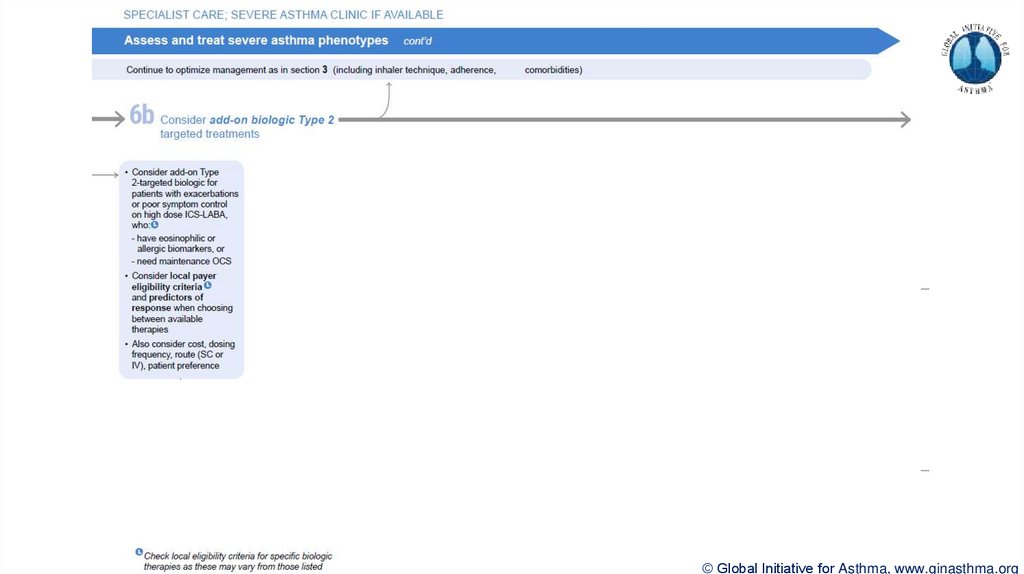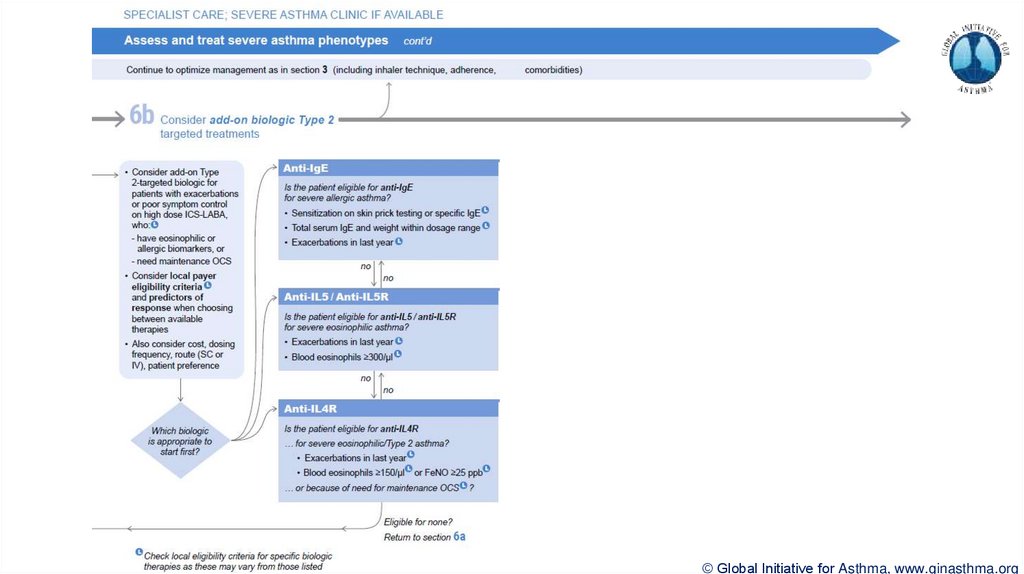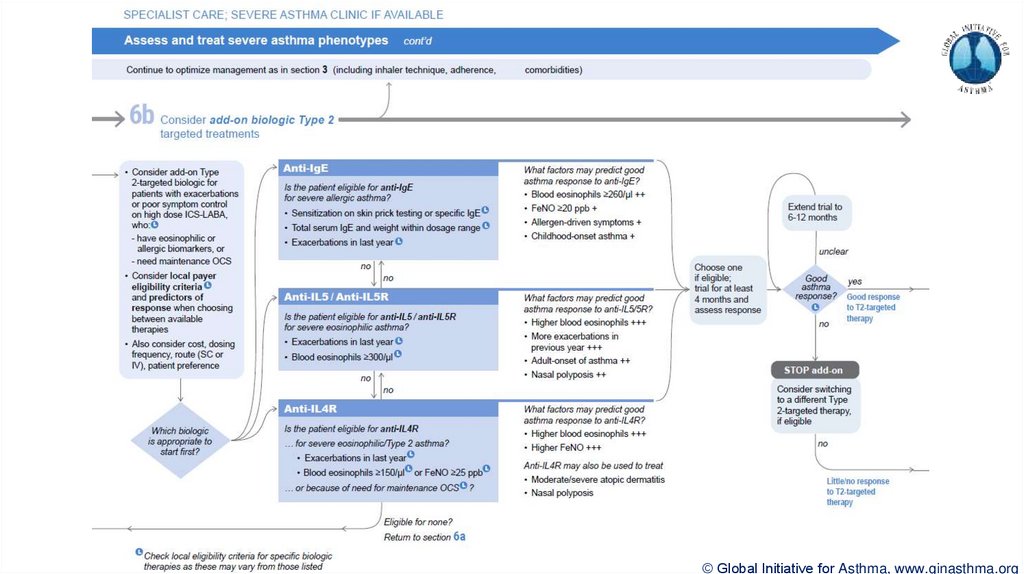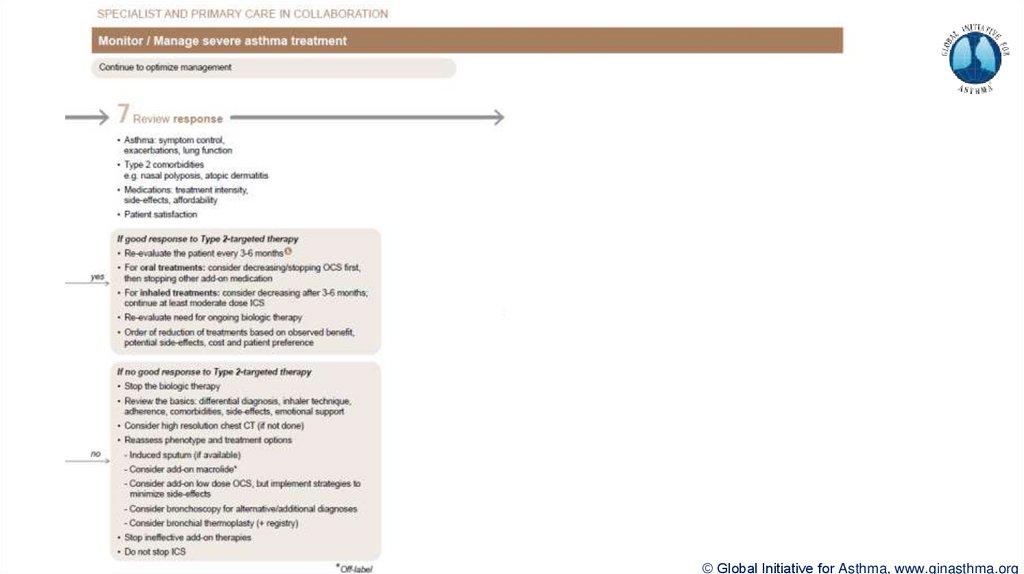Similar presentations:
GINA Pocket Guide Difficult to treat and severe asthma in adults and adolescents
1. GINA Pocket Guide Difficult to treat and severe asthma in adults and adolescents
V2.0 April 2019This slide set is restricted for academic and educational purposes only.
No additions or changes may be made to slides. Use of the slide set or of individual
slides for commercial or promotional purposes requires approval from GINA.
© Global Initiative for Asthma
2. Declaration of interest
[PLEASE ADD YOUR DECLARATION OF INTEREST HERE]The work of GINA is supported only by the sale and licensing of GINA resources
3. Current severe asthma guidelines - 2014
Chung et al, ERJ 2014© Global Initiative for Asthma, www.ginasthma.org
4. Limitations of current resources about severe asthma
Guidelines are costly and time-consuming to develop, and to maintainTypically, guidelines undergo a thorough initial development, with infrequent updates
Conventional evaluation of evidence places a high importance on internal validity
Low importance is given to external validity, despite study populations being highly selected
Recommendations may not be generalizable to patients seen in normal clinical practice
Guidelines are often written in academic language
Evidence is typically compiled as answers to individual PICOT* questions
May have limited relevance to day-to-day clinical practice
Much of current literature on severe asthma focuses on biologic therapies
There are many more patients with difficult-to-treat asthma than with severe asthma, and
clinicians need practical advice about how to distinguish these patients, including in primary care
Advice is also needed by clinicians in areas where biologics are not available or affordable
*PICOT: a framework for constructing research questions – what is the Population, Intervention, Control, Outcome, Time period?
© Global Initiative for Asthma, www.ginasthma.org
5. About the GINA strategy
The GINA report is not a guideline, but an integrated evidence-based strategy focusing ontranslation into clinical practice
Recommendations are framed, not as answers to isolated PICOT questions, but as part of
an integrated strategy, in relation to:
The GINA goals of preventing asthma deaths and exacerbations, as well as
improving symptom control
Current understanding of underlying disease processes
Human behavior (of health professionals and patients/carers)
Implementation in clinical practice
Global variation in populations, health systems and medication access
GINA provides practical resources for clinicians
Figures and tables about implementation in clinical practice: not just ‘what’, but ‘how to’
A survey of GINA Assembly members in 2017 strongly encouraged development of a practical
resource about severe asthma
© Global Initiative for Asthma, www.ginasthma.org
6. Goals of asthma treatment
Few asthma symptoms
No sleep disturbance
No exercise limitation
Maintain normal lung function
Prevent flare-ups (exacerbations)
Prevent asthma deaths
Avoid medication side-effects
The patient’s goals may be different from these
Symptoms and risk may be discordant – need to assess both
Symptom control
Risk reduction
© Global Initiative for Asthma, www.ginasthma.org
7. Terminology
Uncontrolled asthmaFrequent symptoms and/or flare-ups (exacerbations)
Many of these patients may potentially have mild asthma, i.e. their asthma could be
well-controlled with low dose ICS, if taken regularly
Difficult-to-treat asthma
(not difficult patients!)
Asthma uncontrolled despite prescribing high dose preventer treatment
Contributory factors may include incorrect diagnosis, incorrect inhaler technique, poor
adherence, comorbidities
Severe asthma
“Severe asthma” has had many different meanings (Taylor, ERJ 2008; Reddel AJRCCM 2009)
Now defined as asthma that is uncontrolled despite maximal optimised therapy and treatment of
contributory factors, or that worsens when high dose treatment is decreased (Chung, ERJ 2014)
i.e. relatively refractory to corticosteroids (rarely completely refractory)
A retrospective definition, dependent on how thoroughly contributory factors are excluded
© Global Initiative for Asthma, www.ginasthma.org
8. Terminology
Phenotype: The observable characteristics of a disease, such as morphology, development,biochemical or physiological properties, or behaviour.
Patients with an identified phenotype of obstructive lung disease may share a cluster of clinical,
functional and/or inflammatory features, without any implication of a common underlying mechanism
Examples: allergic asthma, aspirin-exacerbated respiratory disease, severe eosinophilic asthma
Endotype: A subtype of disease, defined functionally and pathologically by a distinct
molecular mechanism or by distinct treatment responses (Anderson, Lancet 2008)
Among patients with obstructive lung disease, there are likely to be several specific endotypes
associated with divergent underlying molecular causes, and with distinct treatment responses. These
endotypes may or may not align with clinical or inflammatory phenotypes identified from studies limited
to asthma or to COPD
Examples: emphysema due to alpha1-antitrypsin deficiency
Biomarker: A defined characteristic measured as an indicator of normal biologic processes,
pathogenic processes or response to an intervention
Potential examples: FeNO, blood eosinophils – but these may not meet quality criteria for biomarkers
Anderson, Lancet 2008; Reddel, ERJ Open Res 2019
© Global Initiative for Asthma, www.ginasthma.org
9. How common is severe asthma?
Hekking et al, JACI 2015© Global Initiative for Asthma, www.ginasthma.org
10. How common is severe asthma?
Hekking et al, JACI 2015© Global Initiative for Asthma, www.ginasthma.org
11. How common is severe asthma?
Hekking et al, JACI 2015© Global Initiative for Asthma, www.ginasthma.org
12.
© Global Initiative for Asthma, www.ginasthma.org13. Team who developed pocket guide
Tomoko Ichikawa, Clinical Professor of Design, Information Designer, University ofIllinois
Hugh Musick, Associate Director, Program for Healthcare Delivery Design, University of
Illinois
Helen Reddel, Chair of GINA Science committee
Members of the GINA Science Committee
© Global Initiative for Asthma, www.ginasthma.org
14. Methods used to develop v1.0 of pocket guide
Research: (20+ hours)Familiarized with content area (read papers from prominent authors in the field)
Developed interview protocols
Interviewed key GINA members and external experts/GPs previously identified as
advisors for input
Transcribed interviews
Aligned content with GINA’s existing key messages
Collected existing published guidelines for reference
Researched printing possibilities and limitations
© Global Initiative for Asthma, www.ginasthma.org
15. Methods used to develop V1.0 of pocket guide
Decision tree prototype: (60+ hrs, 20 versions)Synthesized content matter, structured into pocket guide outline provided by content
expert
Parsed textual outline into diagrammatic decision tree structures
Integrated additional inputs from experts and literature
Incorporated feedback from experts, iterated
Incorporated color
Booklet design overall: (20 hrs, 5 versions)
Integrated decision tree to fit booklet format
Formatted detailed text pages to complete the pocket guide
Designed Table of Contents to represent at-a-glance algorithm
Increased total length of pocket guide to 36 pages
V2.0 published in April 2019
© Global Initiative for Asthma, www.ginasthma.org
16.
© Global Initiative for Asthma, www.ginasthma.org17.
© Global Initiative for Asthma, www.ginasthma.org18.
© Global Initiative for Asthma, www.ginasthma.org19.
© Global Initiative for Asthma, www.ginasthma.org20.
© Global Initiative for Asthma, www.ginasthma.org21.
© Global Initiative for Asthma, www.ginasthma.org22.
© Global Initiative for Asthma, www.ginasthma.org23.
© Global Initiative for Asthma, www.ginasthma.org24.
© Global Initiative for Asthma, www.ginasthma.org25.
© Global Initiative for Asthma, www.ginasthma.org26.
© Global Initiative for Asthma, www.ginasthma.org27.
© Global Initiative for Asthma, www.ginasthma.org28.
© Global Initiative for Asthma, www.ginasthma.org29.
© Global Initiative for Asthma, www.ginasthma.org30.
© Global Initiative for Asthma, www.ginasthma.org31.
© Global Initiative for Asthma, www.ginasthma.org32.
© Global Initiative for Asthma, www.ginasthma.org33.
© Global Initiative for Asthma, www.ginasthma.org34.
© Global Initiative for Asthma, www.ginasthma.org35.
© Global Initiative for Asthma, www.ginasthma.org36.
© Global Initiative for Asthma, www.ginasthma.org37.
© Global Initiative for Asthma, www.ginasthma.org38.
© Global Initiative for Asthma, www.ginasthma.org39. Severe Asthma Pocket Guide v2.0: key changes
Section 5: “Could patient have Type 2 airway inflammation?”Criteria for blood/sputum eosinophils and FeNO listed here are the lowest levels associated with
good response to any of the included biologics
These are not the criteria for individual biologic therapies, which come later in the decision tree,
and for which local regulator/payer criteria need to be checked
Addition of need for maintenance OCS, as this may have suppressed evidence of T2 inflammation
Section 6b: Additional class of T2-targeted treatment: anti-IL4 receptor alpha (dupilumab)
Section 6b: review response to initial trial of biologic
For patients with severe eosinophilic asthma or need for maintenance OCS
Consider increasing trial of biologic to 6-12 months if initial response is unclear
Section 7: review response
Process of reviewing need for add-on therapy in patients with good and poor response to biologic
therapy has been clarified







































 medicine
medicine








